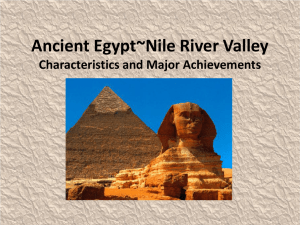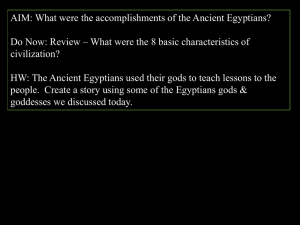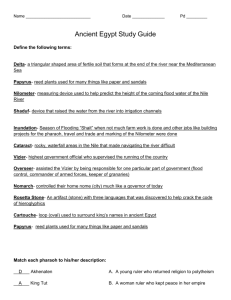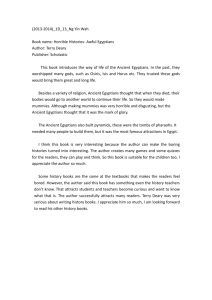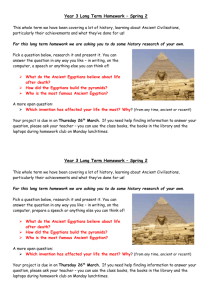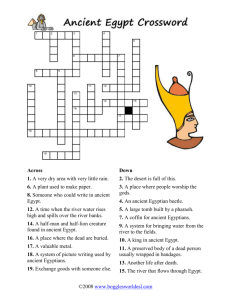Extra Egyptian Facts - Kent City School District
advertisement
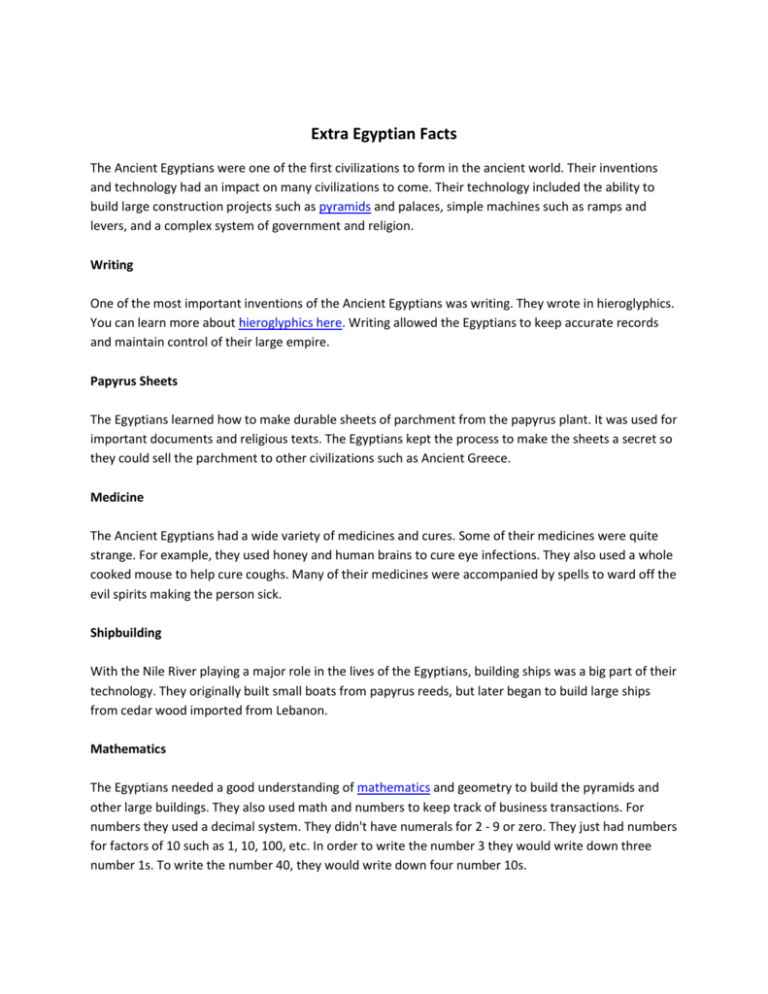
Extra Egyptian Facts The Ancient Egyptians were one of the first civilizations to form in the ancient world. Their inventions and technology had an impact on many civilizations to come. Their technology included the ability to build large construction projects such as pyramids and palaces, simple machines such as ramps and levers, and a complex system of government and religion. Writing One of the most important inventions of the Ancient Egyptians was writing. They wrote in hieroglyphics. You can learn more about hieroglyphics here. Writing allowed the Egyptians to keep accurate records and maintain control of their large empire. Papyrus Sheets The Egyptians learned how to make durable sheets of parchment from the papyrus plant. It was used for important documents and religious texts. The Egyptians kept the process to make the sheets a secret so they could sell the parchment to other civilizations such as Ancient Greece. Medicine The Ancient Egyptians had a wide variety of medicines and cures. Some of their medicines were quite strange. For example, they used honey and human brains to cure eye infections. They also used a whole cooked mouse to help cure coughs. Many of their medicines were accompanied by spells to ward off the evil spirits making the person sick. Shipbuilding With the Nile River playing a major role in the lives of the Egyptians, building ships was a big part of their technology. They originally built small boats from papyrus reeds, but later began to build large ships from cedar wood imported from Lebanon. Mathematics The Egyptians needed a good understanding of mathematics and geometry to build the pyramids and other large buildings. They also used math and numbers to keep track of business transactions. For numbers they used a decimal system. They didn't have numerals for 2 - 9 or zero. They just had numbers for factors of 10 such as 1, 10, 100, etc. In order to write the number 3 they would write down three number 1s. To write the number 40, they would write down four number 10s. Makeup All Egyptians wore makeup, even the men. They made a dark eye makeup called kohl from soot and other minerals. The makeup was a fashion statement, but it also had the side affect of protecting their skin from the hot desert sun. Toothpaste Because their bread had so much grit and sand in it, the Egyptians had a lot of problems with their teeth. They invented the toothbrush and toothpaste in an effort to take care of their teeth. They used a wide variety of ingredients to make their toothpaste including ashes, eggshells, and even ground up ox hooves. Fun Facts about the Inventions of Ancient Egypt The Ancient Egyptians did not start using the wheel until it was introduced by foreign invaders using the chariot. The word for paper comes from the Greek word for the papyrus plant. The Egyptian number for one million was a picture of a god with his arms raised in the air. They invented a game similar to bowling where the bowler tried to roll a ball into a hole. They invented large door locks which used keys. Some of the keys were up to 2 feet long. OBELISK The ancient Egyptians believed if you did not have your name written down somewhere, that after your death, you would disappear. Everyone made sure their name was written somewhere, including inside their tombs and graves. The pharaohs ordered monuments built so they would be remembered. These monuments provided places to write their name down in a very public way. Some monuments were temples. Others were obelisks. Obelisks were made of stone, and often built in pairs. Each obelisk was at least 70 feet tall and most were taller. Each was decorated with writing telling of the great achievements of the person each obelisk honored. This information has told us a great deal about ancient Egyptian life. Cartouche A cartouche was an oval circle with a name written in it, rather like a nameplate. In the early days of ancient Egypt, a cartouche was attached to the coffins of kings and queens. As time went on, many people hired an artist to create a cartouche for their own coffins. The ancient Egyptians believed that you had to have your name written down somewhere, so that you would not disappear when you died. By attaching a cartouche to their coffin, people made sure their name was written down in one place at least! Pyramids It was only during the time of the Old Kingdom that the ancient Egyptians built pyramids to hold the royal tombs of their kings. Pyramids were huge structures. Pyramids had storage rooms, courtyards, secret passageways, and all kinds of fancy traps designed to catch robbers who tried to break into the pyramid to rob it. Pyramids were full of treasures. The average person created grave goods to take with them to their afterlife. Imagine the treasures a pharaoh might feel were necessary to bring along! The first pyramid, the Step Pyramid, was built around 2700 BCE, nearly 5000 years ago! Pyramid construction was abandoned after the time of the Old Kingdom. It was simply too easy to find a pyramid. Grave robbers knew exactly where the pharaohs were buried, and thus knew exactly where to find riches and wealth. If you were caught, the penalty for grave robbing was death. The ancient Egyptians did not simply build a pyramid, bury a pharaoh, and walk away. A whole city grew up around a pyramid during its construction. These cities were called pyramid cities. The pharaoh provided homes for everyone who worked on the pyramid construction. People were paid for their work in goods and food and homes. After a pyramid was finished, the pyramid city continued to exist. Some of the people who stayed had jobs maintaining and guarding the pyramid. Others, like bakers and basket weavers, were merchants who created needed goods. Egyptian number system and fractions The Egyptians invented a decimal system. They used 7 different symbols. 1 was represented by a single stroke. 10 was shown by drawing one hobble. 100 was shown with a drawing one coil of rope. 1,000 was represented by a drawing of one lotus plant. 10,000 was shown as one finger. 100,000 was represented by a drawing of one frog. (A hieroglyphic of six frogs in a row would mean 600,000) 1,000,000 was represented by the figure of a god with raised arms Courts and justice system Several million people lived in ancient Egypt. But they didn't own anything - not their house, not their jewelry or pets or crops or anything. The only person who owned in ancient Egypt was the pharaoh. The pharaoh owned everything. The pharaoh was in charge of everything. To help him do a good job, the pharaoh had helpers - lots and lots of helpers. Some helpers were members of the royal family. Others were people who had worked their way up the government ladder. Each pharaoh had an organized army, a police force, and a huge number of ministers and government officials to assist him. The ancient Egyptians loved titles. So it's not surprising that government officials gave themselves all kinds of titles, some quite elaborate. But in ancient Egypt, the only title that really mattered besides the title of Pharaoh was that of Vizier. The Vizier was Pharaoh's right hand man. Everyone reported to the official above them. The very top officials reported to the Vizier. The Vizier reported to the Pharaoh every day on what was happening all over Egypt. The Vizier was also the judge of the high court. If you had a problem and it was not solved in the local courts, or in the provincial courts, you could bring your problem in front of the Vizier on a first come, first served basis. It was dangerous. The Vizier's decision was final. You could end up in more trouble than you started with. But the Vizier tried to be fair. He had to explain aloud the reason for his decision in each case so that everyone who came to court that day could hear those reasons. This system of government worked successfully in ancient Egypt for hundreds and hundreds of years. Writing System Over 5000 years ago, the ancient Egyptians wrote things down using a picture writing called hieroglyphics. The people who did the actual writing were called scribes. The scribes had a problem. The ancient Egyptians wrote everything down, absolutely everything! Although hieroglyphics were very pretty, it took time to write in pictures. Scribes needed a faster way to write things down. They created a new form of writing called Demotic script. The new scribes did not study the old language of hieroglyphics. They could write much more rapidly with some of the new scripts they created. Hundreds of years later, archaeologists discovered beautiful hieroglyphic writing on the walls of ancient Egyptian pyramids and tombs. The archaeologists had a problem. They knew hieroglyphics had meanings. Although lots of archaeologists could read Demotic script, there was no one left in the world who remembered what the ancient hieroglyphics meant. It was most frustrating! It was not until quite recently, a mere 200 years ago, that a stone was found in Egypt. This stone had the same short story written on it in Greek, in Demotic, and in hieroglyphics. Scientists could read Greek. Scientists could read Demotic. And now, scientists could begin to read hieroglyphics. They named this famous stone the Rosetta Stone. Today, the Rosetta Stone is on display for everyone to see. Currently, it makes its home in the famous British Museum in London. Egyptian Mummies The best way the ancient Egyptians knew how to preserve a body was to mummify it. The poor placed the bodies of their dead relatives out in the sun, in the desert sand. The bodies mummified naturally. Anyone who could afford it went to a professional mummy maker. People wanted to look their best in their afterlife. Papyrus One of the many "Gifts of the Nile" was a weed called papyrus. This weed grew wildly along the shores of the Nile River. The ancient Egyptians used papyrus to make many things, such as baskets, sandals, mats, rope, and paper! Book of the Dead The Book of the Dead is not a book. It's a nickname for a bunch of different magical spells written down in various ways by the ancient Egyptians. Nearly all of the magical spells that have been discovered to date were written to help the ancient Egyptian safely reach their afterlife. Egyptologists have found about 200 different spells so far, most written on piece of papyrus, some written on tomb walls. Everyone in ancient Egypt wanted to safely reach the afterlife. They believed the afterlife was a real place, and they believed magical spells would help them get there. Wealthy Egyptians hired scribes to write down all their personal favorite spells on papyrus sheets. Once prepared, this collection of spells was packed carefully away with their other grave goods, to be placed in their tomb someday. If you did not have a lot of money, you could buy a ready-made version that included several of the most popular spells. A space was left on the sheet of papyrus for your name. That way, you not only had several spells on hand to use, but you also had your name written down, which helped your Ba and your Ka - the two pieces of your soul - find their way home each night to your tomb. If you would like to read some of these ancient spells and magical stories, click on the link below. Once you get used to the style, you'll find it easy reading.
